
Bodrum Castle
Encyclopedia
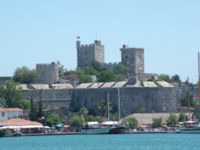
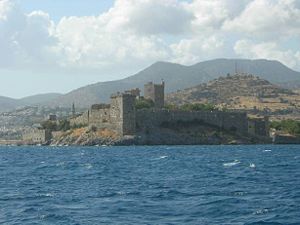
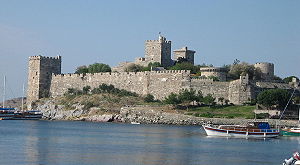

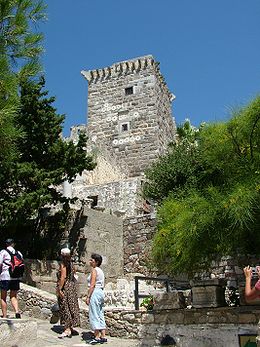

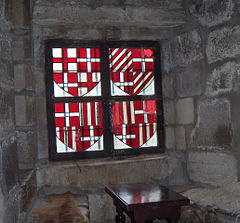
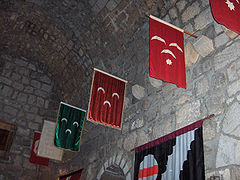
Turkey
Turkey , known officially as the Republic of Turkey , is a Eurasian country located in Western Asia and in East Thrace in Southeastern Europe...
in the city of Bodrum
Bodrum
Bodrum is a port city in Muğla Province, in the southwestern Aegean Region of Turkey. It is located on the southern coast of Bodrum Peninsula, at a point that checks the entry into the Gulf of Gökova. The site was called Halicarnassus of Caria in ancient times and was famous for housing the...
(37°1′54"N 27°25′46"E), was built by the Knights Hospitaller
Knights Hospitaller
The Sovereign Military Hospitaller Order of Saint John of Jerusalem of Rhodes and of Malta , also known as the Sovereign Military Order of Malta , Order of Malta or Knights of Malta, is a Roman Catholic lay religious order, traditionally of military, chivalrous, noble nature. It is the world's...
starting in 1402 as the Castle of St. Peter or Petronium.
History
Confronted with the invasion of SeljukGreat Seljuq Empire
The Great Seljuq Empire was a medieval Persianate, Turko-Persian Sunni Muslim empire, originating from the Qynyq branch of Oghuz Turks. The Seljuq Empire controlled a vast area stretching from the Hindu Kush to eastern Anatolia and from Central Asia to the Persian Gulf...
Turks, the Knights Hospitaller, headquartered on the island of Rhodes
Rhodes
Rhodes is an island in Greece, located in the eastern Aegean Sea. It is the largest of the Dodecanese islands in terms of both land area and population, with a population of 117,007, and also the island group's historical capital. Administratively the island forms a separate municipality within...
, needed another stronghold on the mainland. Grand Master Philibert de Naillac
Philibert de Naillac
Philibert de Naillac was Grand Master of the Knights Hospitaller from 1396 until his death in Rhodes in 1421....
(1396–1421) found a suitable site across the island of Kos
Kos
Kos or Cos is a Greek island in the south Sporades group of the Dodecanese, next to the Gulf of Gökova/Cos. It measures by , and is from the coast of Bodrum, Turkey and the ancient region of Caria. Administratively the island forms a separate municipality within the Kos peripheral unit, which is...
, where there was already a castle of the Order. This location had been already the site of a fortification in Doric times (1110 BC) and of a small Seljuk castle in the 11th century. The same promontory was also the probable site of the palace of Mausolos, the famous king of Caria
Caria
Caria was a region of western Anatolia extending along the coast from mid-Ionia south to Lycia and east to Phrygia. The Ionian and Dorian Greeks colonized the west of it and joined the Carian population in forming Greek-dominated states there...
.
The construction of the castle began in 1402 under the German knight-architect Heinrich Schlegelholt. Construction workers were guaranteed a reservation in Heaven by a papal decree of 1409. They used squared green volcanic stone, marble columns and reliefs from the nearby Mausoleum of Maussollos
Mausoleum of Maussollos
The Mausoleum at Halicarnassus or Tomb of Mausolus was a tomb built between 353 and 350 BC at Halicarnassus for Mausolus, a satrap in the Persian Empire, and Artemisia II of Caria, his wife and sister....
to fortify the castle.
The first walls were completed in 1437. The chapel was among the first completed inner structures (probably 1406). It consists of a vaulted nave and an apse
Apse
In architecture, the apse is a semicircular recess covered with a hemispherical vault or semi-dome...
. The chapel was reconstructed in Gothic style by Spanish Knights in 1519-1520. Their names can be found on two cornerstones of the façade.
Fourteen cisterns for collecting rainwater were excavated in the rocks under the castle.
Each tongue
Tongue (Knights Hospitaller)
Tongues or langues were the geographic-cultural subgroupings of the members of the Knights of Rhodes/Maltese Knights from the 14th to the 18th century...
of the Order had its own tower, each in his own style. Each tongue, each headed by a bailli
Bailli
A bailli was the king’s administrative representative during the ancien régime in northern France, where the bailli was responsible for the application of justice and control of the administration and local finances in his baillage...
, was responsible for the maintenance and defence of a specific portion of the fortress and responsible for manning it with sufficient numbers of knights and soldiers. There were seven gates leading to the inner part of the fortress.
The architect applied the latest in castle design: the passages leading to these gates were full of twists and turns. Eventual assailants could not find cover against the arrows, stones or heated projectiles they had to confront. The Knights had placed above the gates and on the walls hundreds of painted coats of arms and carved reliefs. There remain now 249 separate designs: those of grand masters, castle commandants, countries, personal coat of arms of knights and religious figures.
The construction of the three-storied English tower was finished in 1413. One door opens to the north, to the inner part of the castle; The other door leads to the western rampart
Defensive wall
A defensive wall is a fortification used to protect a city or settlement from potential aggressors. In ancient to modern times, they were used to enclose settlements...
. One could only access this tower via a drawbridge
Drawbridge
A drawbridge is a type of movable bridge typically associated with the entrance of a castle surrounded by a moat. The term is often used to describe all different types of movable bridges, like bascule bridges and lift bridges.-Castle drawbridges:...
. The western façade shows an antique carved relief of a lion. Because of this relief, the tower was also called "the Lion Tower". Above this lion, one can see the coat of arms of king Henry IV of England
Henry IV of England
Henry IV was King of England and Lord of Ireland . He was the ninth King of England of the House of Plantagenet and also asserted his grandfather's claim to the title King of France. He was born at Bolingbroke Castle in Lincolnshire, hence his other name, Henry Bolingbroke...
.
For over a century St. Peter's Castle remained the second most important castle of the Order. It served as a refuge for all Christians in Asia Minor.
The castle came under attack with the rise of the Ottoman Empire, first after the fall of Constantinople in 1453 and again in 1480 by sultan Mehmed II
Mehmed II
Mehmed II , was Sultan of the Ottoman Empire for a short time from 1444 to September 1446, and later from...
. The attacks were repelled by the Knights.
In 1482, Prince Cem
Cem
Prince Cem , December 22, 1459 – February 25, 1495) was a pretender to the Ottoman throne in the 15th century. He was a son of Mehmed II the Conqueror and younger brother of Sultan Bayezid II. He was banished to Europe, first under the protection of the Knights Hospitaller of St...
, son of sultan Mehmed II and brother of sultan Bayezid II
Bayezid II
Bayezid II or Sultân Bayezid-î Velî was the oldest son and successor of Mehmed II, ruling as Sultan of the Ottoman Empire from 1481 to 1512...
, sought refuge in the castle, after a failure in raising a revolt against his brother.
When the Knights decided to fortify the castle in 1494, they used again stones of the Mausoleum. The walls facing the mainland were thickened as to withstand the increasing destructive power of cannons. The walls facing the sea were less thick, since the Order had little to fear from a sea attack due to their powerful naval fleet. Grand Master Fabrizio Del Carretto (1513–21) built a round bastion to strengthen the land side of the fortress.
Sir Thomas Docwra
Thomas Docwra
Thomas Docwra was Grand Prior of the English Knights Hospitaller.Thomas was admitted to the Knights Hospitallers at the age of 16, spending about four years as a novitiate. In 1480 he was in Rhodes with Sir Thomas Greene during the unsuccessful Turkish siege of the island. He later became...
was captain of the castle in 1499.
16th century
Between 1505 and 1507 the few sculptures from the mausoleum, that hadn't been smashed and burnt for lime, were integrated into the castle for decoration. These included twelve slabs of the AmazonomachyAmazonomachy
An Amazonomachy was a portrayal of legendary battle between Greeks and Amazons...
(combat between Amazons
Amazons
The Amazons are a nation of all-female warriors in Greek mythology and Classical antiquity. Herodotus placed them in a region bordering Scythia in Sarmatia...
and Greeks) and a single block of the Centauromachy, a few standing lions and one running leopard.
When faced by attack from Sultan Suleiman
Suleiman the Magnificent
Suleiman I was the tenth and longest-reigning Sultan of the Ottoman Empire, from 1520 to his death in 1566. He is known in the West as Suleiman the Magnificent and in the East, as "The Lawgiver" , for his complete reconstruction of the Ottoman legal system...
, Philippe Villiers de L'Isle-Adam
Philippe Villiers de L'Isle-Adam
Fra' Philippe de Villiers de L'Isle-Adam was a prominent member of the Knights Hospitaller at Rhodes and later Malta. Having risen to the position of Prior of the Langue of Auvergne, he was elected 44th Grand Master of the Order in 1521.He commanded the Order during Sultan Suleiman's long and...
, the Grand Master of the Knights Hospitallers ordered the Castle to be strengthened again. Much of the remaining portions of the mausoleum were broken up and used as building material to fortify the castle. By 1522 almost every block of the mausoleum had been removed.
In June 1522 the sultan attacked the Order's headquarters in Rhodes from the Bay of Marmaris
Marmaris
Marmaris is a port city and a tourist resort on the Mediterranean coast, located in southwest Turkey, in Muğla Province.Marmaris' main source of income is tourism. Little is left of the sleepy fishing village that Marmaris was just a few decades ago after a construction boom in the 1980s...
with 200,000 soldiers. The castle of Rhodes fell in December 1522. The terms of surrender included the handing over of the Knights' fortresses in Kos and St Peter's Castle in Bodrum.
After the surrender, the chapel was turned into a mosque and a minaret was added. This mosque was called the Süleymaniye Camii, as attested by a traveler Evliya Chelebi, who visited Bodrum in 1671. The minaret was destroyed on 26 May 1915 by rounds fired by a French warship during the World War I
World War I
World War I , which was predominantly called the World War or the Great War from its occurrence until 1939, and the First World War or World War I thereafter, was a major war centred in Europe that began on 28 July 1914 and lasted until 11 November 1918...
. It has been reconstructed in its original shape in 1997.
19th century
In 1846 Lord Stratford Canning, the BritishUnited Kingdom
The United Kingdom of Great Britain and Northern IrelandIn the United Kingdom and Dependencies, other languages have been officially recognised as legitimate autochthonous languages under the European Charter for Regional or Minority Languages...
Ambassador to Constantinople
Constantinople
Constantinople was the capital of the Roman, Eastern Roman, Byzantine, Latin, and Ottoman Empires. Throughout most of the Middle Ages, Constantinople was Europe's largest and wealthiest city.-Names:...
obtained permission to take twelve marble reliefs, showing a combat between Greeks
Greeks
The Greeks, also known as the Hellenes , are a nation and ethnic group native to Greece, Cyprus and neighboring regions. They also form a significant diaspora, with Greek communities established around the world....
and Amazons
Amazons
The Amazons are a nation of all-female warriors in Greek mythology and Classical antiquity. Herodotus placed them in a region bordering Scythia in Sarmatia...
. Sir Charles Newton
Charles Thomas Newton
Sir Charles Thomas Newton was a British archaeologist. He was made KCB in 1887.Newton was born at Bredwardine in Herefordshire, and educated at Shrewsbury School and Christ Church, Oxford. He entered the British Museum in 1840 as an assistant in the Antiquities Department...
, a member of the staff of the British Museum, conducted excavations and removed a number of stone lions and one leopard in 1856. Presently, these are all to be found at the British Museum
British Museum
The British Museum is a museum of human history and culture in London. Its collections, which number more than seven million objects, are amongst the largest and most comprehensive in the world and originate from all continents, illustrating and documenting the story of human culture from its...
.
In later years, the castle has been used for different purposes. It was used as a military base by the Turkish army during the Greek Revolt in 1824. In the 19th century the chapel was converted into a mosque and a minaret was added. At the same time a hamam
Hamam
Hamam may refer to:* Turkish bath in Turkish* Hamam , a 1997 European film directed by Ferzan Özpetek* Hamam , brand of soap in India* Sam Hammam , Lebanese businessman and football club owner...
(public bath) was installed in the castle. In 1895 the castle was turned into a prison. During World War I, the castle was fired upon by a French warship, toppling the minaret and damaging several towers. After the war, the Italians stationed a garrison in the castle, but withdrew in 1921 when Mustafa Kemal Atatürk
Mustafa Kemal Atatürk
Mustafa Kemal Atatürk was an Ottoman and Turkish army officer, revolutionary statesman, writer, and the first President of Turkey. He is credited with being the founder of the Republic of Turkey....
came to power. Afterwards the castle stood empty for 40 years.
Museum of Underwater Archaeology
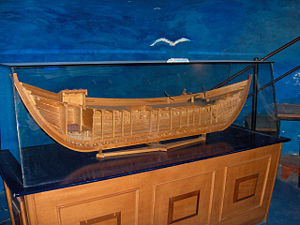
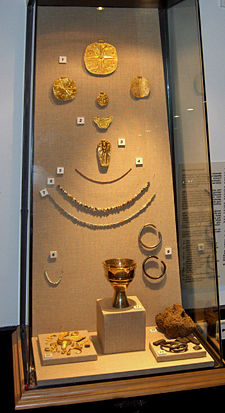
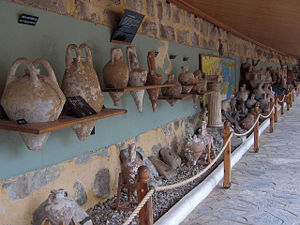
Underwater archaeology
Underwater archaeology is archaeology practised underwater. As with all other branches of archaeology it evolved from its roots in pre-history and in the classical era to include sites from the historical and industrial eras...
, with a vast collection of amphora
Amphora
An amphora is a type of vase-shaped, usually ceramic container with two handles and a long neck narrower than the body...
s, ancient glass, bronze, clay, iron items. It is the biggest of its kind devoted to underwater archaeology. Most of its collection dates from underwater excavations after 1960.
These excavations were performed on several shipwrecks :
- Finike-Gelidonya shipwreck (12th c. BC) : 1958 - 1959 ; first underwater dig in Turkey, showing that Near Eastern merchant ships played a much greater role in the Bronze Age than previously known.
- Bodrum-Yassiada shipwreck (Byzantine, 7 th c. AD) : 1961 - 1964 ; Roman merchant vessel with 900 amphoras.
- Bodrum -Yassiada shipwreck (Late Roman, 4th c. AD)
- Bodrum-Yassiada shipwreck (Ottoman, 16th c. AD) (dated by a sixteenth-century 4-realSpanish realThe real was a unit of currency in Spain for several centuries after the mid-14th century, but changed in value relative to other units introduced...
silver coin from Seville (Philip IIPhilip II of SpainPhilip II was King of Spain, Portugal, Naples, Sicily, and, while married to Mary I, King of England and Ireland. He was lord of the Seventeen Provinces from 1556 until 1581, holding various titles for the individual territories such as duke or count....
) ) - Ṣeytan Deresi shipwreck (16th c. BC)
- Marmaris-Serçe harbour shipwreck (glass, 11th c. AD) : 1977; amazing collection of Islamic glassware
- Marmaris-Serçe harbour shipwreck (Hellenistic, 3rd BC)
- Kaṣ-Uluburun shipwreck (14th c. BC) : 1982 - 1995; 10 tons of Cypriot copper ingots; one ton of pure tin ingots; 150 glass ingots; manufactured goods; Mycenaean pottery; Egyptian seals (with a seal of queen NefertitiNefertitiNefertiti was the Great Royal Wife of the Egyptian Pharaoh Akhenaten. Nefertiti and her husband were known for a religious revolution, in which they started to worship one god only...
) and jewelry - Tektaṣ glasswreck (5th c. BC) : (1996–2001)
The former chapel houses an exhibition of vases and amphoras form the Mycenaean age
Mycenae
Mycenae is an archaeological site in Greece, located about 90 km south-west of Athens, in the north-eastern Peloponnese. Argos is 11 km to the south; Corinth, 48 km to the north...
(14-12th c. BC) and findings from the Bronze Age
Bronze Age
The Bronze Age is a period characterized by the use of copper and its alloy bronze as the chief hard materials in the manufacture of some implements and weapons. Chronologically, it stands between the Stone Age and Iron Age...
(around 2500 BC). The many commercial amphoras give a historical overview of the development of amphoras and their varied uses.
The Italian Tower houses in the Coin and Jewelry Hall a large collection spanning many centuries.
Another exhibition room is devoted exclusively to the tomb of a Caria
Caria
Caria was a region of western Anatolia extending along the coast from mid-Ionia south to Lycia and east to Phrygia. The Ionian and Dorian Greeks colonized the west of it and joined the Carian population in forming Greek-dominated states there...
n princess, who died between 360 and 325 BC.
The collection of ancient glass objects is one of the four biggest ancient glass collections in the world.
Two ancient shipwrecks have been reconstructed : the Fatımi ship, detected as sunken 935 years ago, and the large Uluburun Shipwreck
Uluburun shipwreck
The Uluburun Shipwreck is a Late Bronze Age shipwreck dated to the late 14th century BCE, discovered off Uluburun situated about 6 miles southeast of Kaş, in south-western Turkey...
from the 14th century BC.
The garden inside the castle is a collection of almost every plant and tree of the Mediterranean region, some of which have a mythological significance : the myrtle was dedicated to Aphrodite
Aphrodite
Aphrodite is the Greek goddess of love, beauty, pleasure, and procreation.Her Roman equivalent is the goddess .Historically, her cult in Greece was imported from, or influenced by, the cult of Astarte in Phoenicia....
; the shadow of the plane tree
Platanus orientalis
Platanus orientalis, or the Oriental plane, is a large, deciduous tree of the Platanaceae family, known for its longevity and spreading crown. The species name derives from its historical distribution eastward from the Balkans, where it was recognized in ancient Greek history and literature....
was sought after by kings and noblemen, as it was thought to strengthen one's health.
External links
- Bodrum History and Bodrum Castle
- Bodrum Castle information, photos and map of Bodrum Castle
- Historical Places Around Bodrum
- Bodrum museum virtual tour

